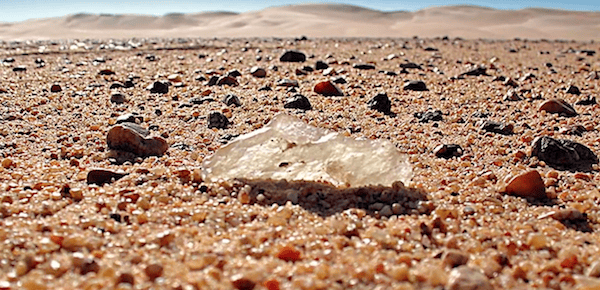
[Image above] Credit: Mike Chen, Beyond Science; YouTube
A discovery of unusual glass stones has led scientists to question the origins of our solar system and how it was formed.
Back in 1996, unusual yellow glass stones were found by a scientist in a virtually uninhabited place on Earth—The Great Sand Sea. In 2013, researchers at the University of Johannesburg determined that minerals in the stone—which they named Hypatia, after a female mathematician and astronomer—were not from our planet. In 2015, other researchers found that the stones were not part of any known meteorites or comets that have been studied.
Research professor Jan Kramers and senior research fellow Georgy Belyanin in the Department of Geology at Johannesburg believe that the Hypatia stone was part of an extraterrestrial rock, probably several meters in diameter, that fell to Earth and broke into hundreds of fragments.
It’s not that extraordinary, since meteorites periodically fall to Earth. What makes it noteworthy is that Hypatia’s mineral makeup is atypical of meteorites that have fallen to Earth.
“If it were possible to grind up the entire planet Earth to dust in a huge mortar and pestle, we would get dust with on average a similar chemical composition as chondritic meteorites,” Kramers says in a Johannesburg news release. “In chondritic meteorites, we expect to see a small amount of carbon and a good amount of silicon. But Hypatia’s matrix has a massive amount of carbon and an unusually small amount of silicon.”
In addition to the unusual ratio of carbon and silicon, the matrix contains polyaromatic hydrocarbons (PAH), the stuff of interstellar dust. Most of the PAH was turned into small diamonds, which the researchers believed were formed upon impact with the Earth.
And the researchers observed something else—pure metallic aluminum as well as silver iodine phosphide and silicon carbide in “highly unexpected forms.”
“The aluminum occurs in pure metallic form, on its own, not in a chemical compound with other elements,” Belyanin says in the release. “As a comparison, gold occurs in nuggets, but aluminum never does. This occurrence is extremely rare on Earth and the rest of our solar system, as far as is known in science.”

A sample of pure metallic aluminum that was found with other elements in Hypatia. Credit: Beyond Science, Mike Chen; YouTube
The scientists theorize that the minerals and other materials that combined to create Hypatia have been in existence since before our solar system even formed.
“We know very little about the chemical compositions of space objects out there,” Kramers notes. “So our next question will dig further into where Hypatia came from.”
You can read more about the research in the Johannesburg news release here.
The paper, published in Geochimica et Cosmochimica Acta, is “Petrography of the carbonaceous, diamond-bearing stone “Hypatia” from southwest Egypt: A contribution to the debate on its origin” (DOI: 10.1016/j.gca.2017.12.020).
Mike Chen summarizes the researchers’ findings in this five-minute video below.

Credit: Beyond Science; YouTube
Did you find this article interesting? Subscribe to the Ceramic Tech Today newsletter to continue to read more articles about the latest news in the ceramic and glass industry! Visit this link to get started.
Author
Faye Oney
CTT Categories
- Aeronautics & Space
- Art & Archaeology
- Environment
- Glass
- Material Innovations
Related Posts
Celebrating the US Semiquincentennial: Ohio Creativity Trail
December 16, 2025


